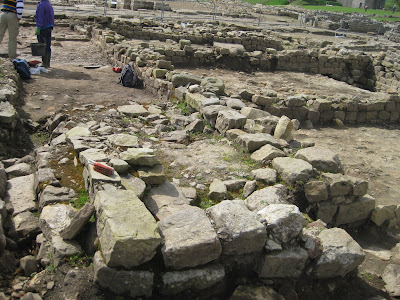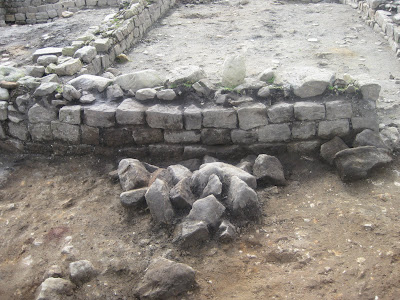Vindolanda Week Two Final Report
Pictures sometimes do a better job than words. Here is the focus of our week's work.....it appears to be a barracks room from the late 300s overlying a road from the 200s which of course overlies many other earlier features. The Before Picture:
And, after five days work, many wheelbarrows of rock and soil removed, here is the site all cleaned up on the last day:
The angle of the photo is somewhat different, but you can clearly see the odd accumulation of rock right in the middle of the road. Perhaps some kind of fill for a sunken area? Or just where some rocks fell out when something got demolished.
I did not get to find out, as the weather turned soggy the last two days. We ducked in and out of shelter, and our progress was much slowed. In particular we were not able to excavate a feature such as the above, as all low spots turned into sticky goo that does not trowel well, and in which artifacts are difficult to see.
Another digger up the street a bit resorted to unusual measures to attempt to influence the weather--he built a small altar out of a rectangular wall stone, decorated it with various colored pebbles and placed small offerings of rusty nails and bits of brick in front of it! To little apparent effect.
I can't report any brilliant finds in my two weeks over here, but as always it has been marvelous fun. Great company with my fellow obsessed enthusiasts, excellent walks in the green countryside, and some very nice ale.
I look forward to returning next year, and as such have left a bit of my digging "kit" in the storage room of the Twice Brewed Inn. Mostly stuff spouse would regard as too shabby for wearing anywhere but a dig site.
Homeward Bound



2 comments:
Hope you had a safe journey back Tim. Thanks very much for the postings. Always find them interesting.
Brian will keep your kit safe for next year. Vale for now! Hadriana/Catherine :)
Hi again,
I think it was you who queried about the actual Celtic origin of the name "Vindolanda". My Welsh ain't great but this is what www.roman-britain.org/places/vindolanda.htm
says on the subject:
The Roman fort at Chesterholm is thus named Vindolana or Vindolande in the geographies, while an inscription from an altar recovered in the neighbourhood refers to the civilian inhabitants as the Vindolandesses (RIB 1700). The name now accepted is Vindolanda which has been variously interpreted as 'The White Cross' or 'The White Enclosure'. Compare modern Welsh: gwyn-dafadfa 'white sheep-fold'.
Post a Comment